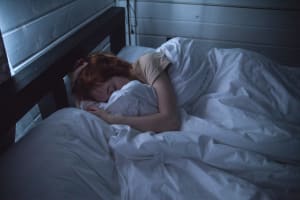
When you awake at dawn or grow sleepy in the evening, more is at work than a lifetime of habit. Underpinning our bodies’ and our brains’ sleep-wake cycle is a complex regulatory apparatus known as the Circadian System, and it is responsible for keeping us biologically in tune with the world around us.
In our modern world of hectic schedules, artificial light, and information overload, knowing what the circadian system is, and how it works, can help you achieve better sleep patterns and a more well-adjusted life.
Circadian System: Sleep Rhythm Explained
The circadian system might be better explained by talking about the more well-known concept: the “circadian” rhythm. This is the daily internal clock or cycle of sorts that our body keeps. An approximately 24-hour cycle in which our body moves in and out of sleep and wakefulness depending on the time of day. This circadian clock is maintained by the circadian system, which draws cues from the environment to make sure that our internal clock is set to keep aligned with the outside world.
Specifically, it is the light-dark cycle of night and day that helps us regulate our own biological clocks. Most species operate on some version of this internal clock, though not all regulate their own sleeping times and wake cycles in the same way humans do. For example, nocturnal animals rely on their internal rhythms to be alert during the evening and seek sleep during sunlight hours.
The circadian systems are ancient and have interested biologists for centuries. Staying in sync with these natural circadian cycles in our environment as night turns into day, and vice versa, continues to award us a massive evolutionary advantage for all species. The study of the circadian systems is chronobiology.
How Does Circadian System work?
Chronobiologists have a remarkably clear understanding of how the circadian system works in human beings. Here is a brief overview of how it functions.
In the human brain, a collection of over 20,000 neurons make up a structure called the suprachiasmatic nucleus (SCN). The SCN is the most important part of our internal clock. It works with a variety of other brain structures to interpret external signals from the environment into physiological outputs such as hormone production, digestion, body temperature and more.
Light is the most crucial of these cues. It enters through the eyes before moving through the optic nerves to the hypothalamus, where the SCN is located. When there is a great deal of light in our environment, the SCN interprets this as daytime and regulates our bodies accordingly by raising body temperature, releasing stimulating hormones and other functions. When there is no light present, the SCN assumes that it is evening and works with other brain structures to prepare for sleep and its associated neurological activities.
A key component of the night-time cycle is the production of melatonin, a hormone that regulates drowsiness.
The changes to our physiology stimulated by the SCN influence our behaviors to keep us in tune with the natural day-night cycle of the earth. However, as anyone who has moved between time zones will tell you, the circadian system often requires a period of adjustment to sync up to dramatic shifts in the cycle. Also known as Jet-Lag.
There is even evidence that the circadian system continues to operate in the absence of the typical environment cues like light. That suggests that there is a somewhat ingrained quality to the 24-hour cycle we rely on.

Sleep Disorders and the circadian system
Sleep patterns are clearly linked to the circadian system and the rhythms it produces. The times we feel sleepy and active are in part rooted in our bodies’ interpretations of what time of day it is. In this respect, when our circadian system isn’t functioning properly, it can have dramatic consequences for our sleep health.
According to the Cleveland Clinic, some of the most common disorders relating to sleep patterns and the circadian system include:
- Jetlag: Though this “disorder” is temporary, it is probably the most common circadian related sleep problem. It results from a conflict between the body’s internal clock, and cues from the environment which are shifted when you move between time zones. This can result in difficulty getting to sleep, and sleepiness during waking hours of the day. In time, your body will adjust to new environmental cues on its own.
- Narcolepsy: The symptoms of this disorder, which include excessive daytime sleepiness and spontaneous onset of sleep, are thought to arise from problems with the sleep-wake cycle and circadian system function.
- Shift Work Disorder: Shift work disorder can occur when an individual works non-daytime hours, and especially when they intersperse shifts in both the night and day. Patients can experience insomnia and disturbances when they try to sleep, and excess drowsiness during waking hours.
- Delayed and Advanced Sleep Disorder: Both of these disorders refer to abnormal timeframes for sleeping and waking.
- Delayed sleep disorder sees patients falling asleep very late at night and waking up very late the next day. It is most common in adolescents and young adults.
- Advanced sleep disorder is the opposite. This disorder results in patients falling asleep very early in the evening, and waking extremely early in the morning. Typically only affecting older adults.
Hacking your system for better sleep
Here are a few tips that will help you work with your internal clock to achieve the best possible sleep:
- Avoid artificial lights at night: Any light that is not sunlight can trick your body into thinking it’s not quite time for sleep. Try to avoid being in artificially bright environments before bed. This also means not using electronics like computers, phones, and tablets, or television in the hours before you sleep.
- Establish a regular sleep schedule: The more you can keep your waking and sleeping hours regular, the easier it will be for your body to establish the good sleep patterns and move through the stages of sleep better. This doesn’t just mean trying to sleep and rise at the same times each day, but also choosing when to expose yourself to light, the most important circadian cue. This is especially important if you work irregular hours.
- Some medications can help adjust your circadian system: Melatonin and other sleep-regulating drugs can help you to adjust your sleep schedule as desired. This is especially effective for adjusting to jet lag. Use under doctor supervision, and in coordination with other behavioral changes.

